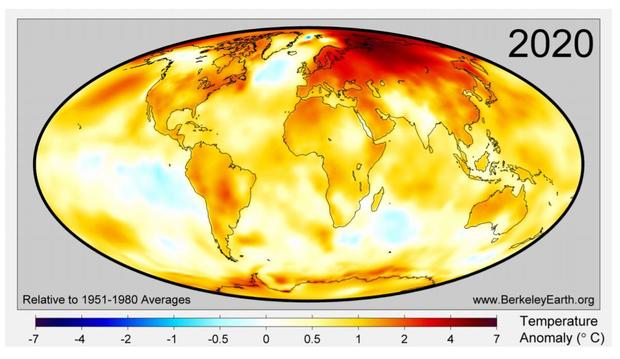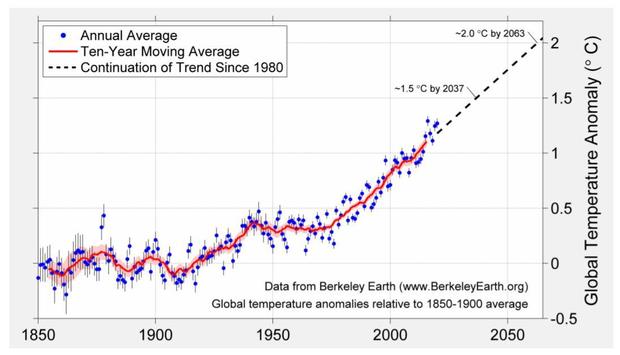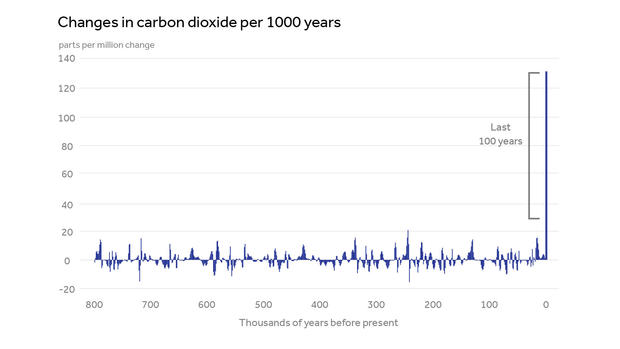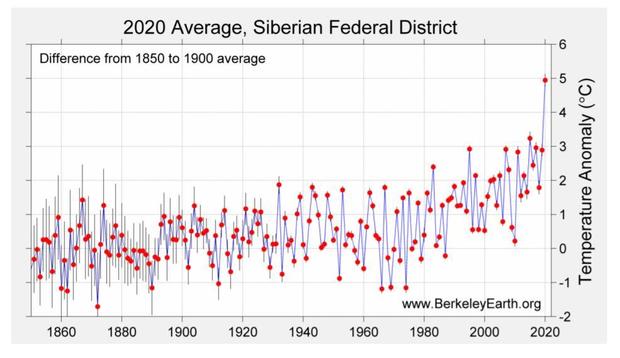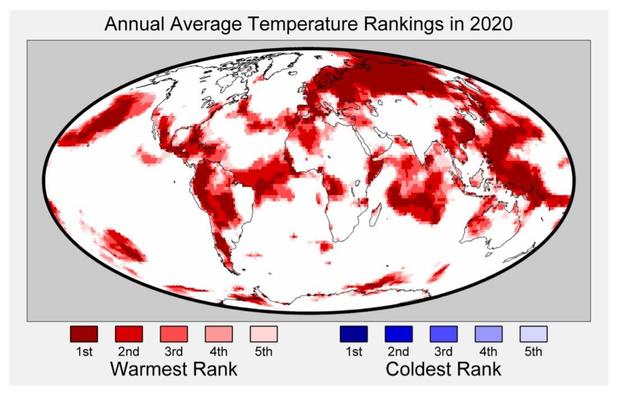2020 is "effectively tied" for warmest year on record
NASA, NOAA and Berkeley Earth all released their assessments of Earth's temperature in 2020 on Thursday. The conclusion: 2020 was nearly tied with 2016 for the warmest year globally on record.
NOAA's data shows global temperatures were just 0.04 of a degree Fahrenheit below the record high set in 2016 — making it officially the second warmest ever, but so close that it's "effectively tied," according to scientists from Berkeley Earth.
Headlines like this have become commonplace every January when the major climate monitoring agencies tally the numbers for the year before. Because of human-caused climate change, the last six years have been the warmest six years in the record books, which date back into the 1800s.
NOAA concludes the United States had its fifth warmest year on record, with all five of the warmest years occurring since 2012. This warmth was boosted by severe heat waves across the Southwest last summer, with much of the southwestern quarter of the nation experiencing its hottest year on record.
The U.S. Climate Extremes Index (USCEI) for 2020 was 80% above average and ranked as seventh highest in the 111-year record due to extreme heat, drought and hurricane activity.
According to Berkeley Earth, global mean temperature in 2020 — which includes both surface air and ocean temperatures — is estimated to have been 1.27 °C (2.29 °F) above the pre-industrial 1850-1900 average. Pre-industrial is the time before greenhouse gases from the burning of fossil fuels started to impact the climate. That means the planet is only a quarter of a degree away from surpassing the Paris Agreement goal of staying below 1.5 °C of warming.
Using extrapolation, Dr, Robert Rohde, the author of the Berkeley Earth report, estimates that at the current rate we will surpass 1.5 °C of warming in just 15 years and exceed 2 °C of warming by 2065. But that pace can be slowed to some degree depending on how fast we reduce heat-trapping greenhouse gas emissions.
Since the mid 1800s levels of carbon dioxide in the atmosphere have jumped from 280 parts per million to 415 parts per million. They are now higher than any time in the last 3 million years, if not longer. In the "Carbon Skyscraper" chart below by Dr. Scott Kulp from Climate Central, you can see just how abrupt the change in carbon dioxide has been in the past century compared to the previous 800,000 years.
As a result, Earth's temperature is changing at a rate 100 times faster than what happened in the last Ice Age.
Scientists from NASA and NOAA held a briefing Thursday afternoon to discuss the latest findings about Earth's escalating fever.
Because each agency uses slightly different data and different methods to analyze that data, the assessments differ slightly, but all fall within a few hundredths of a degree of each other.
NASA's GIS dataset shows 2020 as the warmest year, but only by a minuscule margin, whereas the NOAA and Berkeley Earth data show 2020 a hair behind 2016 for the warmest year globally on record. Just last week the European climate agency Copernicus showed 2020 tied with 2016.
Although we have come to expect each new year to be one of the warmest on record, 2020 should not have been able to reach such heights. That's because this fall a La Niña event developed, which cooled the overall global surface temperature by two-tenths of a degree, according to Berkeley Earth.
La Niña and El Niño are semi-annual natural oscillations in the tropical Pacific Ocean. La Niña is characterized by cool surface waters in the eastern tropical Pacific, while El Niño is the opposite, characterized by warmer than normal surface waters. Because they cover a vast area in a very heat-rich part of the world, they have the ability to affect global temperatures.
In 2016 there was a super El Niño — one of the strongest on record. The event released vast amounts of heat which easily propelled 2016 to the warmest year globally on record. This year, despite the cool La Niña event in the Pacific, 2020 still managed to tie 2016. Without the La Niña cooling, 2020 would have been solidly in the No. 1 position. This illustrates just how powerful human-caused warming has become.
If you take the oceans out of the equation, on land 2020 was far and away the warmest year on record, having warmed almost 2 °C above pre-industrial levels. This warming dries out vegetation and soil, expands deserts and inflames wildfires like those that tore through the western U.S. in recent months.
2020's global temperature was especially enhanced by astonishing warmth in the Arctic and Russia. Because of Arctic amplification, a phenomenon where decreased ice and snow leads to a warming feedback, the Arctic is warming at three times the pace of the global average.
In Siberia, temperatures were off the charts in 2020, finishing the year a remarkable 5 °C (9 °F) above normal. The graph below shows just how abnormal the heat in Siberia was in 2020.
The warmth wasn't just confined to Siberia. Rohde from Berkeley Earth says 87% of the Earth was significantly above normal in 2020 and 10% saw record average annual warmth. No region experienced a record cold annual average.
While Earth's surface temperature is at the mercy of fluctuations on natural climate cycles, which is why temperatures go up and down year to year, the ocean is a lot more stable. As a result the oceans have been warming at a more steady rate.
In a separate report released on Wednesday, 20 scientists from 13 institutions from around the world reported that 2020 had the highest upper ocean temperatures on record. The study focused on the upper 2,000 meters of the world's oceans. The oceans act like a bank account accumulating interest — more than 90% of excess heat from climate change is stored in the oceans.
All in all, the various reports lead to the same conclusion: Earth's temperature continues to march upwards due to continued greenhouse gas emissions. The good news, scientists say, is that if society chooses to reduce emissions to near zero in the coming decades, the global warming trend could be stopped rather quickly, lessening the most severe impacts of climate change.
